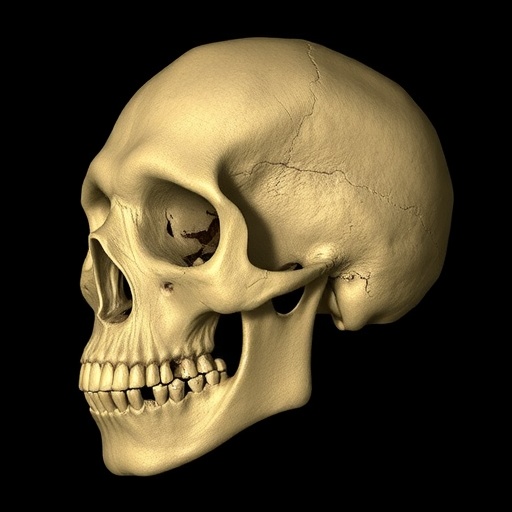A groundbreaking study published in Science on September 25, 2025, unveils new insights into the evolutionary trajectory of the enigmatic Homo longi lineage and its close kinship with both modern humans and Denisovans. The research, focused on the nearly one-million-year-old Yunxian 2 cranium recovered from China, achieves a remarkable feat by digitally reconstructing the fossil, overcoming previous distortions and damage that clouded its proper classification. This reconstruction propels a fundamental shift in our understanding of human evolution during the Middle Pleistocene — a period marked by the coexistence and diversification of multiple Homo lineages with complex, mosaic anatomical traits.
The Yunxian 2 cranium had long perplexed paleoanthropologists due to its unusual combination of features. Historically, the fossil was interpreted as ambiguous, displaying a puzzling blend of primitive Homo erectus characteristics alongside traits reminiscent of later Homo sapiens. However, the fossil’s integrity was compromised by considerable deformation, notably compression that obscured key anatomical landmarks essential for precise phylogenetic placement. This ambiguity impeded its definitive assignment within the human evolutionary tree and fueled ongoing debate over the diversity of archaic hominins in Asia.
Leveraging state-of-the-art CT scanning technology and innovative digital reconstruction techniques, lead researcher Xiaobo Feng and colleagues meticulously corrected the cranium’s severe distortions. This approach allowed for an unprecedentedly accurate morphological analysis, revealing a much clearer anatomical profile of Yunxian 2. The reconstructed specimen showed a suite of distinctive traits including an enlarged braincase, narrower orbital spacing, a pronounced glabellar depression, and a characteristic low, elongated frontal bone, all morphologies emblematic of the Asian Homo longi clade, a sister lineage to Homo sapiens.
Phylogenetic analyses incorporating the digitally corrected Yunxian 2 cranium unearth a complex picture of its evolutionary affiliations. The fossil’s assemblage of both archaic and derived traits places it firmly within the Homo longi clade, which is hypothesized to encompass the mysterious Denisovans. These findings not only clarify the position of Yunxian 2 but also reinforce the concept of an extended network of hominin diversity across Asia during the Middle Pleistocene, characterized by rapid speciation events and trait mosaicism.
Remarkably, the study designates the Yunxian specimens as the oldest known representatives of the Homo longi group, though they are not the most basal members, indicating an evolutionary phase of significant diversification. The hybrid morphology of Yunxian 2—melding primitive and advanced features—may signal a transitional form capturing early small-scale evolutionary dynamics that eventually yielded the longi clade and modern humans.
The implications of these findings extend far beyond resolving a single fossil’s taxonomy. They fundamentally recast Homo longi as an important and distinct lineage with potentially widespread influence on the hominin evolutionary landscape in Asia. Moreover, the research emphasizes the role of digital paleoneurology and virtual restoration in overcoming traditional fossil preservation limitations, marking a revolution in paleoanthropological methodology.
This robust new placement of Yunxian 2 also deepens the debate concerning archaic hominin admixture and migration. It dovetails with genetic and fossil data suggesting that Denisovans and Homo sapiens share a close evolutionary relationship with Homo longi. Such a network of interrelated lineages may have been more geographically and temporally extensive than previously thought, complicating simplistic linear models of human ancestry.
Furthermore, the identification of specific morphological features unique to Homo longi—such as the glabellar depression and elongated frontal bone—provides refined anatomical markers for future fossil findings. This enhances the paleoanthropological toolkit used to discriminate among hominin fossils from similar timeframes, allowing scientists to pinpoint evolutionary relationships with greater confidence.
Importantly, the study exemplifies how integrating multidisciplinary scientific advances—ranging from high-resolution imaging to computational phylogenetics—can unlock evolutionary narratives obscured for decades. The techniques applied here create a blueprint for revisiting and reinterpreting other problematic fossils, potentially reshaping the broader narrative of human evolution in multiple regions.
Taken together, the research underscores a crucial period in hominin evolution during the Middle Pleistocene: one characterized by complex lineage branching, hybrid morphologies, and the emergence of distinct sister groups such as Homo longi alongside early Homo sapiens ancestors. These insights challenge the conventional view of a straightforward human evolutionary path, emphasizing instead a dynamic, reticulated process shaped by ecological diversity and evolutionary experimentation.
Future research will likely focus on locating additional Homo longi specimens and closely related fossils to trace the geographic spread and adaptive strategies of this lineage. Genetic studies, where possible, may further unravel connections between Homo longi and Denisovans, enriching our understanding of hominin interbreeding and gene flow events.
In sum, the digital resurrection of the Yunxian 2 cranium not only revives an ancient hominin’s visage but also breathes new life into our understanding of how modern humans and their closest extinct relatives evolved. This discovery sheds light on a complex hominin past, inviting a reevaluation of what it means to be human and underscoring the intricate evolutionary dance that has shaped our species’ origins.
Subject of Research: The phylogenetic classification and evolutionary implications of the nearly one-million-year-old Yunxian 2 cranium, focusing on its relationship to Homo longi and Denisovans.
Article Title: The phylogenetic position of the Yunxian cranium elucidates the origin of Homo longi and the Denisovans
News Publication Date: 25-Sep-2025
Web References: https://doi.org/10.1126/science.ado9202
Keywords: Homo longi, Yunxian 2 cranium, Middle Pleistocene, fossil reconstruction, CT scanning, Denisovans, human evolution, phylogenetics, archaic hominins, digital paleoneurology, morphological analysis, evolutionary diversification




